How do I tune a ukulele ?
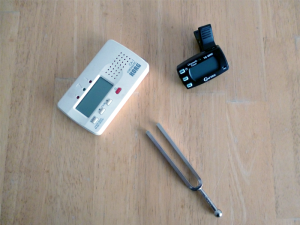 That’s a question beginner ask me a lot.
If you asked this question yourself, then this article is for you. Probably you have noticed that your instrument is out of tune. Congratulations! Because a basis for tuning an instrument is the ability to hear that an instrument is not tuned properly.
That’s not that easy und it takes a while and needs a little practice to be able to hear if a ukulele is in tune or not. There a a lot ukulele players who play an instrument that is not in tune. There are instruments you can’t tune at all. Some tend to get out of tune all the time.
That’s a question beginner ask me a lot.
If you asked this question yourself, then this article is for you. Probably you have noticed that your instrument is out of tune. Congratulations! Because a basis for tuning an instrument is the ability to hear that an instrument is not tuned properly.
That’s not that easy und it takes a while and needs a little practice to be able to hear if a ukulele is in tune or not. There a a lot ukulele players who play an instrument that is not in tune. There are instruments you can’t tune at all. Some tend to get out of tune all the time.
How do i change the pitch of a string ?
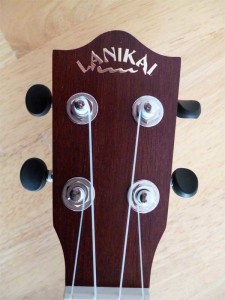 You can change the pitch of a string by putting tension on it. The more tension you put on a string the higher it will sound. You can adjust the tension of a string by using (turning) the tuning pegs (at the headstock of the ukulele).
Make sure that you don’t put too much tension on the strings. Because at some point the string will rupture.
You can change the pitch of a string by putting tension on it. The more tension you put on a string the higher it will sound. You can adjust the tension of a string by using (turning) the tuning pegs (at the headstock of the ukulele).
Make sure that you don’t put too much tension on the strings. Because at some point the string will rupture.
Different methods of tuning a ukulele
 Method 1: Relative Tuning
Method 1: Relative Tuning
I will show you the relative tuning using the example of the g-C-E-A (high 4th) tuning.
What you need is the tone for the first string . In this case it is the tone A. This tone you can get from a tuner (which is producing tones), from a tuning fork, a flute, a pitch pipe, a piano, a flute …
Pitch pipes are not that accurate.
If you do not these things at hand you can use a dial tone of a fixed phone (A) to tune the string.
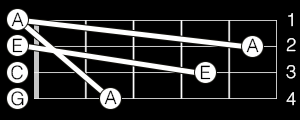
String no. 1 (A)
Tune the first string by carefully turning the tuning peg until the pitch of the string matches the tone A. This takes a little practice and concentration. The more often you do that the quicker you will get the string tuned.String no. 2 (E)
Now you will tune string no. 2. (second from the bottom). Grab the 5th fret of the second string. Now turn the tuning peg of the second string until the pitch of string no.1 one and string no.2 match. (1st string = 2nd string/5th fret)String no. 3 (C)
Now you will tune string no. 3. (third from bottom). Grab the 4th fret of the third string. Now turn the tuning peg of the third string until the pitch of string no.2 one and string no.3 match. (2nd string = 3rd string/4th fret)String no. 4 (G)
Now you will tune string no. 4. (fourth from bottom). Grab the 2nd fret of the fourth string. Now turn the tuning peg of the fourth string until the pitch of string no.1 one and string no.4 match. (1st string = 4th string/2nd fret) Method 2: tuning using reference tones
Method 2: tuning using reference tones
This method is not hard to explain. For each string of the ukulele you have a reference tone. You tune string until the pitch of tone and string match. You can find the reference tones of different tunings at the end of the page.
 Method 3: Tuning using an electronic tuner
Method 3: Tuning using an electronic tuner
An electronic tuner is a measurement device. You pick a string and the tuner measures the pitch of the tone and shows the value (the matching tone of the scale) on a display. It also shows you if you have to pitch the tone higher or lower.
There are different types of electronic tuners:
Ukulele Clip Tuner
A cliptuner is a tuner you attach to the headstock of the ukulele. Usually it uses the vibration of the instrument to measure the pitch of the tone. Cliptuner are pretty cheap and in most cases sufficient for beginners For example the Snark SN6 Clip-On Ukulele TunerTuner with a built-in microphone / Chromatic Tuner
Tuner with a built-in microphone
This type of tuner determines the pitch by using a microphone. You put the tuner in front of you, because they even work from a little distance. You can also put the ukulele in front of you (the sound hole pointing upwards) and put the tuner on top of the instrument next to the soundhole.
Chromatic Tuner
„Chromatic“ means that the tuner can display all tones of the chromatic scale: C,C#(Db),D,D#(Eb),E,F,F#(Gb),G,G#(Ab),A,A#(Bb),B.
Most tuners on the market are chromatic tuners.
For example the Korg CA-40 Large Display Auto Chromatic Tuner
 Method 4: Tuning using an app
Method 4: Tuning using an app
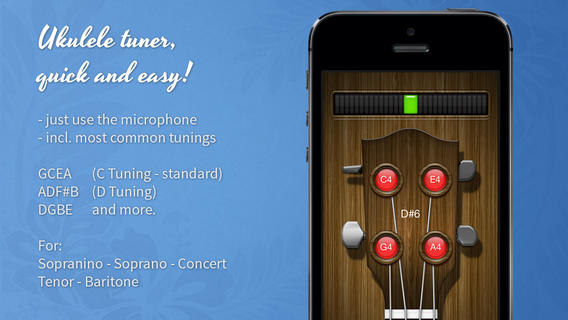 If you have a smartphone or a tablet with an built in microphone (i bet you have), you can use an app to tune your ukulele. Many apps have similar functionality like electronic tuners. Some have reference tones and preset tunings. If want to use an app, check out the „Ukulele Chromatic Tuner“ with many preset tunings, reference tones and microphone based tone recognition. The apps differ in handling, look and accuracy. Just take a look at the stores.
If you have a smartphone or a tablet with an built in microphone (i bet you have), you can use an app to tune your ukulele. Many apps have similar functionality like electronic tuners. Some have reference tones and preset tunings. If want to use an app, check out the „Ukulele Chromatic Tuner“ with many preset tunings, reference tones and microphone based tone recognition. The apps differ in handling, look and accuracy. Just take a look at the stores.
Get "Ukulele Chromatic Tuner" for iPhone, iPad here:
Method 1 and method 2 explained: (g-C-E-A / standard tuning):
Which ukulele tuning should I use ?
There are several different ukulele tunings. It depends on the kind of instrument and on your taste which tuning you prefer. I have picked 5 different most popular tunings. There's a great chance that your preferred tuning is among them.
1. g-C-E-A tuning (high 4th)
(sopran ukulele)
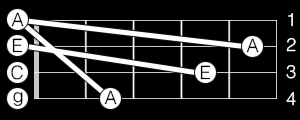
(1.) A
(2.) E
(3.) C
(4.) g
This is by far the most popular tuning. Most tutorials and videos on the internet use this tuning. It is also called reentrant tuning. Sometimes it is called „C6 with high 4th String“, sometimes it is called Standard tuning.
The 4th string is not the string with the lowest tuning. That differs from the guitar tuning, where the upper string is also the string with the lowest tuning.
2. G-C-E-A tuning (low 4th)
(sopran ukulele)
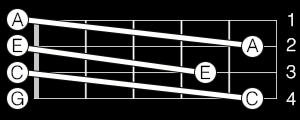
(1.) A
(2.) E
(3.) C
(4.) G
This tuning differs from the first tuning. The fourth string (G) is tuned one octave down. This tuning is often used by players who play solo parts or melodies.
3. a-D-F#-B tuning (high 4th)
(sopran ukulele)
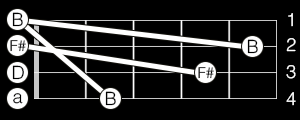
(1.) B
(2.) F#
(3.) D
(4.) a
This tuning is very common in Canada. It was made popular by the ukulele wizard James Hill. Because of the higher tuning, the tension on the strings is often a little bit higher.
4. A-D-F#-B tuning (low 4th)
(sopran ukulele)
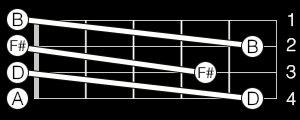
(1.) B
(2.) F#
(3.) D
(4.) A
Same tuning like tuning no. 3. The only difference here is that the fourth string is tuned on octave down.
5.D-G-B-E tuning
(baritone ukulele)
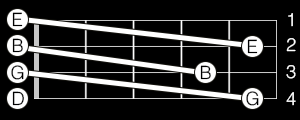
(1.) E
(2.) B
(3.) G
(4.) D
The baritone ukulele is tuned like the first 4 strings of a guitar. The instrument sounds more like a guitar than a ukulele.
Is it possible to tune my instrument properly at all ?
If a ukulele is very hard to tune or it gets out of tune very quickly, it is often due to the lack of quality of the strings. Especially cheaper ukuleles are shipped with low quality strings. You should change those strings. It is important to choose the right strings. They should match the type of ukulele (sopran, tenor) and the preferred tuning (e.g. g-C-E-A). You can find those informations printed on the packing of the strings. If you have put on new strings, it takes up to one week until the strings stay in tune. If the strings sound fine and in tune when played without grabbing a fret but sound out of tune when grabbing a chord It is probably the ukulele that is causing the problem not the tuning. Often the distance between the frets and the strings ( also called the action ) is relatively high to avoid buzzes when the instrument is shipped from the manufacturer. Some ukuleles are not fretted good . For a beginner it is hard to tell if this problem can be fixed. Just let an expert take a look at your instrument. It is always useful to let an expert make a setup. But this is worth the effort usually only for mid- and high priced ukuleles. FriendlyFred

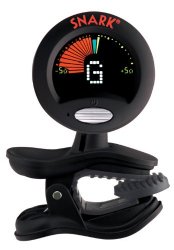
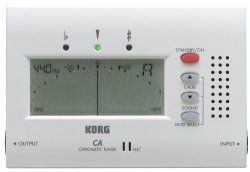
hey mate,
i hope u had a nice weekend so far 😉
my name is fran and i started to learn to play an ukulele with ur tutorials. U re a champ!!!
however, this might be a stupid wuestion but i do not have any knowledge bout ukuleles (yet) Anyways, I tried to tune my ukulele in A-E-C-G but it did not work out so i went to a guitar shop and he tuned it to A-E-D-G it does sound nice but i am wondering if this i right or if i just start to mess it up right in the beginning 😀
have an awesome weekend,
greetings from holland
fran
Hi Fran,
standard tuning is g C E A ( from top to the bottom ). Unlike guitar tuning, the 4th ( on top ) isn’t the highest tone. Lay the ukulele in front of you and tune every string by using the video in the article as reference. If you have a tenor ukulele, maybe they put on some low g strings. Then the 4th string is one octave lower. Get to know the standard tuning before you try others. There are regular ukulele meetings in the Netherlands ( I think in Amsterdam ). Take a look at ukuleleunderground.com/forum for more informations.
And next time go to another music store.
Best wishes
FriendlyFred